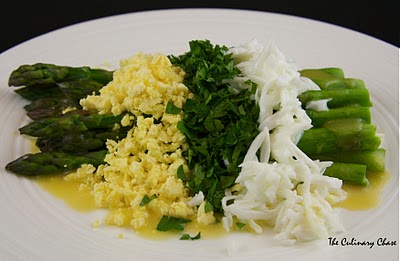Asparagus Salad
Parsley is the world’s most popular herb. A sprig of parsley can provide much more than a decoration on your plate. In addition to its volatile oils and flavonoids, parsley is an excellent source of vitamin C and vitamin A ( two vital nutrients that are also important for the prevention of many diseases) and a good source of folic acid (one of the most important B vitamins). Parsley has been cultivated for more than 2,000 years and was used medicinally prior to being consumed as a food. The two most popular types of parsley are curly parsley and Italian flat leaf parsley. The Italian variety has a more fragrant and less bitter taste than the curly variety.
Asparagus comes in different grades (small, standard, large) and colors (green, white and purple). Green asparagus, the most common, ranges from pencil-thin to very thick. White asparagus, due to sunlight-deprived stalks, are a little milder and more delicate in taste. Asparagus needs to be cooked quickly to a tender-crisp texture. An excellent source of vitamin K, A, and C and this humble perennial is also a natural diuretic.
Serves 2
recipe adapted from Valentine Warner as shown in Woman & Home magazine
print this recipe
asparagus
2 eggs
handful parsley leaves, finely chopped
Vinaigrette:
1 heaped teaspoon Dijon mustard
squeeze of lemon juice
1 cupful (or 2 depending upon taste) of tarragon or white wine vinegar
1 teaspoon caster sugar
50ml (2 oz.) good extra virgin olive oil
Place eggs in a saucepan with water, place lid on saucepan and bring to a boil. Once the water has boiled, turn off heat and set the timer for 13 minutes. When done, drain water and put the eggs in a bowl of cold water to cool completely (a warm egg isn’t easy to grate). Peel eggs, separating the white from the yolk. Grate the white on a medium setting of a box grater before grating the yolk in the same way.
Prepare the asparagus by cutting off and discarding the coarse woody and use a vegetable peeler to cut away any blemishes. Wash the stalks thoroughly in warm water. Steam or microwave asparagus until al dente and plunge into ice water to prevent from further cooking. For the vinaigrette, mix mustard, lemon juice, vinegar, sugar and a pinch of salt in a bowl before slowly beating in the olive oil with a fork or whisk. It will emulsify into a creamy consistency.
To assemble, pile asparagus on a plate. Spoon the vinaigrette over all of the asparagus before sprinkling over the egg yolk, parsley and egg white.
The Culinary Chase’s Note: This recipe calls for leeks which are in season in Spring, Summer and Autumn. However, as my luck would have it, the only leeks I could find were exceptionally huge (read: good if you’re a giant!) so a slight change to the menu and asparagus it was. This is a dish I will definitely make again and again!
By the Glass Tasting Note: This may be a case where you surrender your wine glass as asparagus, eggs and vinegar are all ingredients that can kill wine. Here’s a case where a lager with some intensity or lighter style ale is the solution. Asparagus can make all but the most acidic wines taste sweet, not to mention its intense flavour can permeate through all but the most intense wines. Throw in the textural issue eggs play and the vinegar further pushing dry wines to the sweet spectrum (the acidity of the vinegar negates the acidity in wine making it taste sweeter) and you’ve no choice but opt for the cleansing nature of beer. Given Germany’s love of asparagus you could do much worse than choosing a German Kolsch, a hoppy German lager or even a Weissbier.

